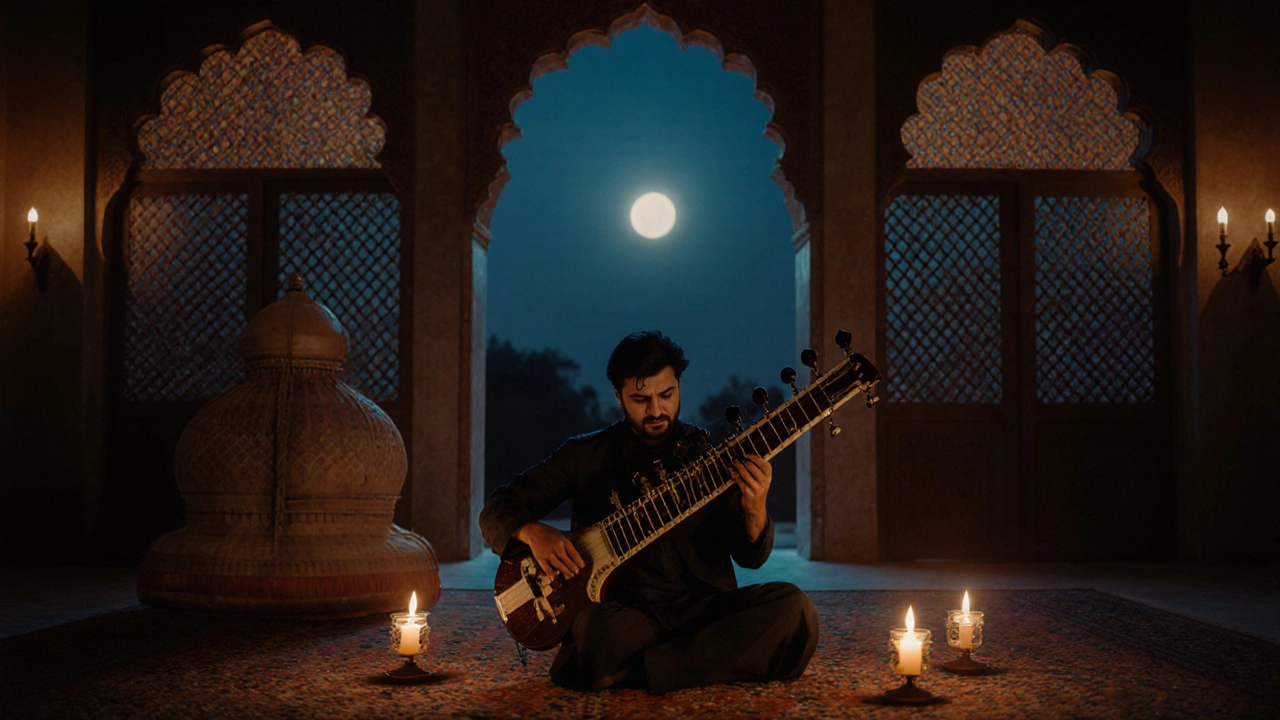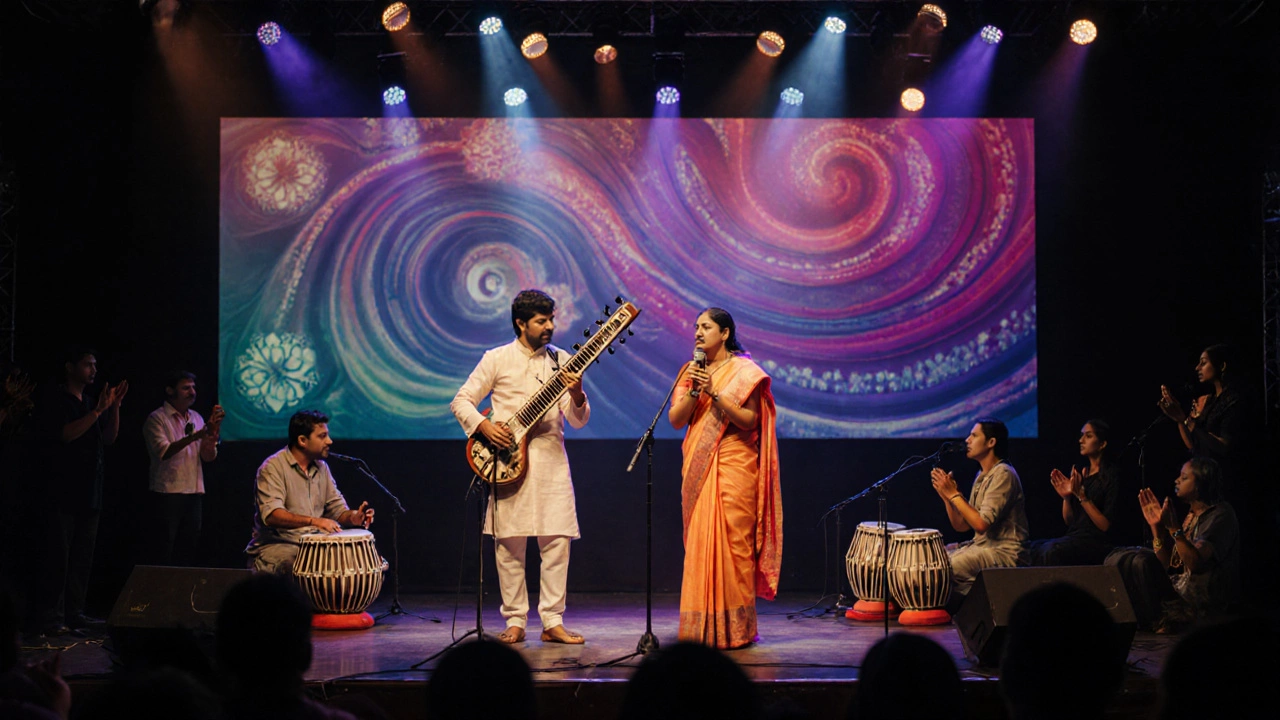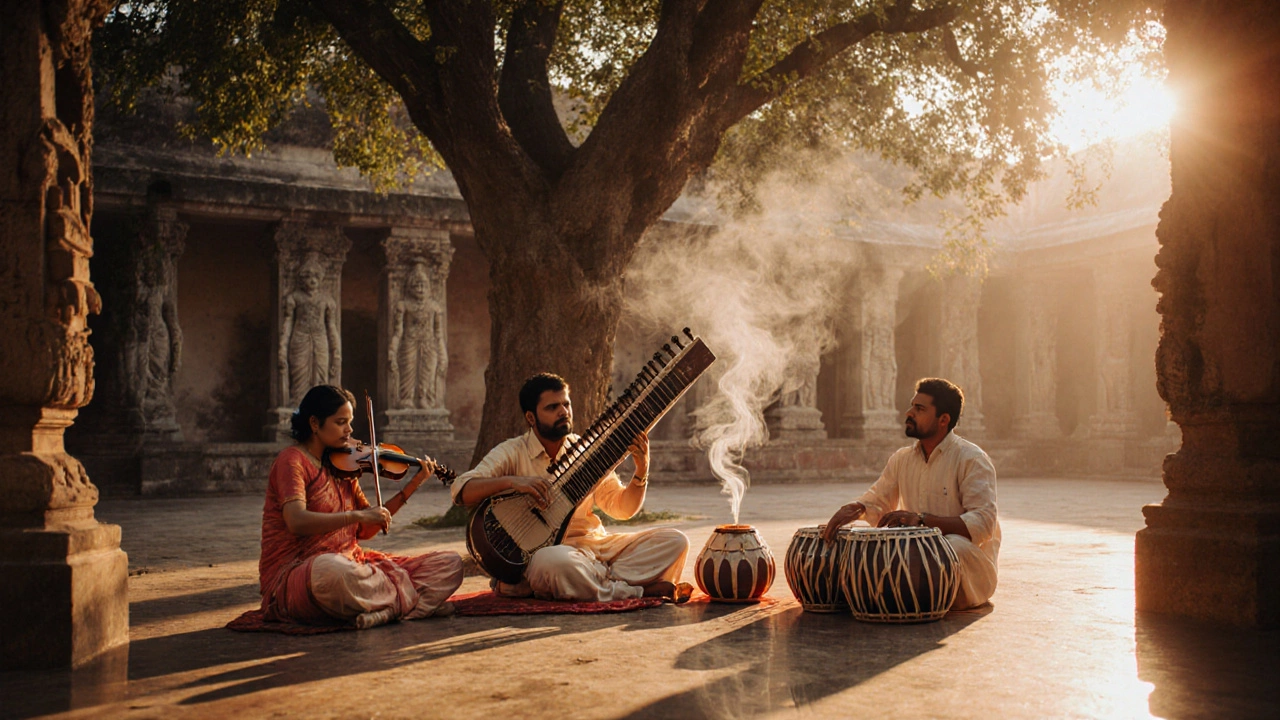Think of Indian classical music as two rivers flowing from the same mountain - same source, but different paths. One runs through the north, shaped by Mughal courts and Persian influences. The other flows through the south, rooted in temple rituals and ancient texts. These are Hindustani and Carnatic classical music. They’re both deeply spiritual, technically complex, and passed down for centuries. But if you listen closely, you’ll hear they don’t sound alike. And it’s not just about instruments or ragas. The whole structure, the way they’re taught, even how performers improvise - it’s different.
Where Did They Come From?
Hindustani music developed in northern India, especially around Delhi, Agra, and Lucknow. After the 12th century, Islamic rulers brought Persian and Central Asian sounds into local traditions. Instruments like the sitar and tabla evolved here. The language of lyrics shifted to Urdu and Persian-influenced Hindi. Gharanas - family-based lineages of musicians - became the backbone of teaching. A student didn’t just learn notes; they lived with their guru, absorbing style, discipline, and even daily routines.
Carnatic music stayed closer to its roots in the southern states - Tamil Nadu, Karnataka, Andhra Pradesh, and Kerala. It never absorbed the same level of foreign influence. Its foundation is the ancient Sanskrit texts like the Natya Shastra. The music stayed tied to Hindu devotional practices. Composers like Tyagaraja, Muthuswami Dikshitar, and Syama Sastri wrote hundreds of kritis - songs that are still performed today. These aren’t just melodies; they’re prayers in musical form.
The Structure: Raga and Tala Are Different
Both systems use ragas (melodic frameworks) and talas (rhythmic cycles). But they don’t use them the same way.
In Hindustani music, a raga is explored slowly. A performance might start with an alap - a free-rhythm, unmetered section where the musician slowly unfolds the mood of the raga. You might hear just the drone of the tanpura and the soft hum of the sitar for ten minutes before the rhythm kicks in. The focus is on emotion, atmosphere, and gradual build-up.
Carnatic music starts with structure. Even the opening piece - the varnam - has fixed lyrics and rhythm. The entire performance follows a set order: varnam, kriti, ragam-tanam-pallavi, tillana. There’s less room for open-ended improvisation at the start. The rhythm is more tightly woven into the melody from the beginning.
And the talas? Hindustani uses 12 main talas, like teental (16 beats) or jhaptal (10 beats). Carnatic has 7 core talas, but they can be expanded into 35 or more through combinations. The most common, Adi tala, has 8 beats - but the way it’s counted, clapped, and felt is different. In Carnatic, the hand movements are precise, almost dance-like. In Hindustani, the tabla player might subtly shift accents to create tension.
Instruments: Different Tools, Different Sounds
The instruments tell the story. Hindustani music leans on string and wind instruments. The sitar, with its sympathetic strings and buzzing bridge, creates a shimmering, resonant sound. The sarod, with its metal fingerboard, is deeper and more metallic. The bansuri (bamboo flute) and shehnai (double-reed oboe) carry the melody. The tabla - two drums, one wooden, one metal - is the heartbeat of the rhythm.
Carnatic music is built around the veena - a plucked string instrument with a long neck and gourd resonators. It’s ancient, elegant, and hard to master. The violin, introduced in the 18th century, became central because it can mimic the human voice. Percussion? The mridangam - a double-headed drum made of wood and animal skin - is the backbone. It’s played with the fingers and palm, producing a wide range of tones. Ghatam (clay pot) and kanjira (frame drum) add texture.
Notice something? Hindustani uses more percussion variety. Carnatic relies on one main drum but layers it with subtle hand techniques. The violin in Carnatic doesn’t just accompany - it duets with the vocalist. In Hindustani, the sarangi or harmonium might support, but rarely leads.

Performance Style: Solo vs. Ensemble
Hindustani performances are often solo-focused. One musician, maybe with a tabla player and tanpura, holds the stage. The audience watches the artist’s journey - how they stretch a note, how they surprise with a quick taan (fast melodic run). The mood can shift from meditative to energetic within minutes. There’s space for silence. For breath.
Carnatic concerts are more like group rituals. A vocalist leads, flanked by a violinist on one side and a mridangam player on the other. A second percussionist might play ghatam or kanjira. The audience doesn’t just listen - they respond. They hum along. They clap in rhythm. They shout ‘Bravo!’ in Tamil or Telugu. The energy is communal. Even the improvisation - like the neraval (repeating a line with melodic variations) or swara kalpana (improvised solfa syllables) - is done in dialogue with the ensemble.
Teaching: Guru-Shishya vs. Formal Classes
In Hindustani music, the guru-shishya parampara (teacher-student tradition) is still alive. You might live with your teacher for years. Learning isn’t about sheet music - it’s about imitation, memory, and feeling. A single raga can take months to internalize. There’s no standardized exam. Progress is measured in how deeply you’ve absorbed the style.
Carnatic music has adapted to modern education. You can study at universities, take graded exams (like those from the Music Academy in Chennai), and use printed notation. Students learn from textbooks, recordings, and online lessons. But even here, the guru remains respected. The difference? Carnatic teaching is more systematized. You learn the 72 melakarta ragas - a full catalog - early on. Hindustani musicians might focus on 10-20 core ragas over a lifetime.

Repertoire: Songs vs. Spiritual Poetry
Hindustani music has thumris, dadras, and ghazals - lighter forms that often deal with love, longing, and separation. The lyrics are poetic, sometimes romantic, sometimes mystical. Even in serious ragas, the emotional tone can be personal.
Carnatic music is mostly devotional. Most kritis are addressed to gods - Krishna, Shiva, Vishnu. The lyrics are in Sanskrit, Telugu, or Tamil. Even when the melody is complex, the purpose is worship. A Carnatic concert is as much a spiritual offering as a musical performance.
Why Does It Matter?
It’s not about which is better. It’s about which speaks to you. If you like slow, expansive melodies with room for silence and deep emotion - Hindustani might draw you in. If you prefer tightly woven rhythms, layered textures, and music that feels like a collective prayer - Carnatic will resonate.
Both systems are alive. Both are evolving. Young artists in Bangalore and Delhi are blending them with jazz, electronic music, and film scores. But the core remains: one is a quiet temple chant, the other is a courtly conversation. Both are Indian classical music. Just not the same.
Can Hindustani and Carnatic musicians play together?
Yes, but it’s rare and requires deep understanding. Some fusion projects exist - like when a sitar player joins a Carnatic ensemble. But because the tuning systems, rhythmic cycles, and improvisation styles differ, it’s not easy. A Hindustani musician might struggle with the fixed structure of a kriti, while a Carnatic artist might find the open alap too vague. The best collaborations happen when both sides respect the other’s rules and find common ground in rhythm or emotion.
Which one is older?
Both trace back to the same ancient roots in the Natya Shastra (circa 200 BCE-200 CE). But Carnatic music preserved those roots more directly. Hindustani music changed significantly after the 12th century due to Islamic influences. So while they share a common origin, Carnatic stayed closer to the original form. Hindustani evolved into something new.
Is one harder to learn than the other?
Neither is objectively harder - but they demand different skills. Hindustani requires patience and emotional depth. You need to sit with silence and let a raga unfold slowly. Carnatic demands precision. You must memorize hundreds of compositions and master complex rhythmic patterns. A Carnatic student might learn 50 songs in a year. A Hindustani student might spend a year on one raga. It’s not about difficulty - it’s about focus.
Do they use the same notes?
They use the same seven basic notes - Sa, Re, Ga, Ma, Pa, Dha, Ni. But the microtones (shrutis) are treated differently. In Hindustani, some notes are bent or slid into, creating a fluid feel. In Carnatic, the same note might be sharper or flatter depending on the raga, but the transitions are more defined. Also, Carnatic uses a fixed pitch system (like A=440 Hz), while Hindustani often adjusts tuning based on the raga or vocalist’s range.
Can I learn both?
Absolutely. Many musicians today study both. But it’s best to master one first. Trying to learn both at the same time can lead to confusion - especially with tuning, ornamentation, and improvisation styles. Once you understand the logic of one system, the other becomes easier to appreciate and integrate. Some artists even create hybrid forms - but only after years of deep study in each.
